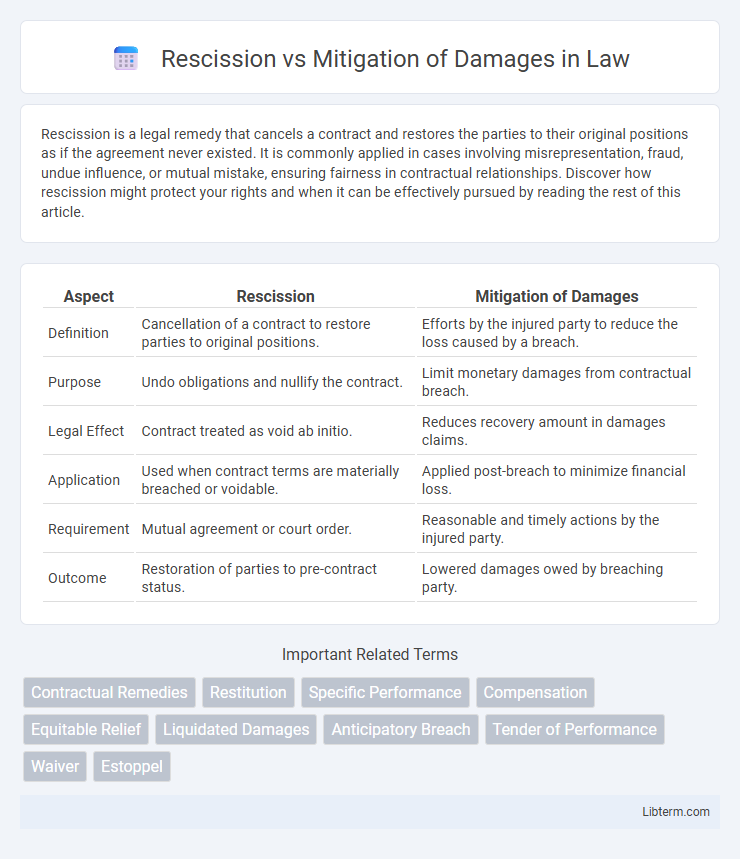Rescission is a legal remedy that cancels a contract and restores the parties to their original positions as if the agreement never existed. It is commonly applied in cases involving misrepresentation, fraud, undue influence, or mutual mistake, ensuring fairness in contractual relationships. Discover how rescission might protect your rights and when it can be effectively pursued by reading the rest of this article.
Table of Comparison
| Aspect | Rescission | Mitigation of Damages |
|---|---|---|
| Definition | Cancellation of a contract to restore parties to original positions. | Efforts by the injured party to reduce the loss caused by a breach. |
| Purpose | Undo obligations and nullify the contract. | Limit monetary damages from contractual breach. |
| Legal Effect | Contract treated as void ab initio. | Reduces recovery amount in damages claims. |
| Application | Used when contract terms are materially breached or voidable. | Applied post-breach to minimize financial loss. |
| Requirement | Mutual agreement or court order. | Reasonable and timely actions by the injured party. |
| Outcome | Restoration of parties to pre-contract status. | Lowered damages owed by breaching party. |
Introduction to Rescission and Mitigation of Damages
Rescission involves the cancellation of a contract, aiming to restore the parties to their pre-contractual positions by unwinding the agreement due to factors like misrepresentation or breach. Mitigation of damages requires the injured party to take reasonable steps to minimize the loss resulting from the breach, preventing unnecessary escalation of damages. Understanding the distinction ensures proper legal recourse and equitable remedies in contract disputes.
Defining Rescission in Contract Law
Rescission in contract law refers to the legal remedy that voids a contract, restoring the parties to their original positions as if the agreement never existed. This remedy is typically granted when there has been a material misrepresentation, fraud, undue influence, or mutual mistake affecting the contract's validity. Unlike mitigation of damages, which minimizes losses after a breach, rescission aims to nullify the contract entirely to prevent unjust enrichment.
Understanding Mitigation of Damages
Mitigation of damages requires the injured party to take reasonable steps to minimize losses after a breach of contract, preventing the other party from being unfairly burdened with avoidable expenses. This principle applies primarily in contract and tort law, where the claimant must demonstrate efforts to reduce the financial impact of the breach. Failure to mitigate can result in the reduction of recoverable damages, emphasizing the duty to act prudently and avoid unnecessary costs.
Key Differences Between Rescission and Mitigation
Rescission involves canceling a contract and restoring parties to their original positions, while mitigation of damages requires the injured party to take reasonable steps to minimize losses after a breach. Rescission nullifies contractual obligations entirely, whereas mitigation aims to reduce the monetary impact of the breach without terminating the contract. The fundamental difference lies in rescission's focus on undoing the contract versus mitigation's focus on limiting financial harm.
Legal Grounds for Rescission
Legal grounds for rescission include fraud, misrepresentation, duress, undue influence, mutual mistake, and failure of consideration, each invalidating the contract and restoring parties to their pre-contractual positions. Rescission is an equitable remedy allowing parties to avoid obligations when consent was not genuinely given or essential terms were fundamentally flawed. Courts typically require prompt action and restoration of benefits to the other party for rescission to be granted.
Legal Requirements for Mitigation of Damages
Legal requirements for mitigation of damages mandate that the injured party must take reasonable steps to reduce the loss after a breach of contract occurs. This involves actively seeking alternatives or solutions that minimize financial harm, ensuring damages claimed are not unnecessarily inflated. Courts assess whether the mitigation efforts were practical and proportionate to the circumstances to determine recoverable damages.
Practical Examples: Rescission vs Mitigation
In contract law, rescission involves canceling the contract and restoring both parties to their pre-contractual positions, such as when a buyer returns a defective product and receives a full refund. Mitigation of damages requires the non-breaching party to take reasonable steps to reduce losses, like a tenant finding a new renter to cover unpaid rent after the original tenant breaches a lease. Understanding these practical applications helps parties decide whether to seek contract cancellation or minimize damages through continued performance or alternative arrangements.
Impacts on Parties: Remedies and Liabilities
Rescission nullifies the contract, restoring parties to their pre-contractual positions, effectively eliminating ongoing obligations and requiring the return of exchanged benefits to prevent unjust enrichment. Mitigation of damages compels the injured party to take reasonable steps to reduce losses, influencing liability by potentially limiting recoverable damages if mitigation is not pursued. These remedies impact parties by either terminating contractual duties entirely through rescission or altering damage awards and liability exposure based on the injured party's mitigation efforts.
Common Mistakes in Navigating Rescission and Mitigation
Common mistakes in navigating rescission and mitigation of damages include failing to clearly distinguish between the two remedies, leading to improper application in contract disputes. Parties often neglect timely communication or documentation that is crucial for enforcing rescission or proving mitigation efforts, weakening their legal position. Misunderstanding the legal criteria for rescission versus the obligation to mitigate damages results in lost opportunities for recovery or unnecessary liability exposure.
Conclusion: Choosing the Right Legal Remedy
Selecting the appropriate legal remedy between rescission and mitigation of damages depends on the nature of the contract breach and the desired outcome. Rescission nullifies the contract, restoring parties to their original positions, while mitigation of damages seeks to minimize financial loss without voiding the agreement. Understanding the specific circumstances and legal implications is crucial for effectively protecting contractual rights and interests.
Rescission Infographic

 libterm.com
libterm.com